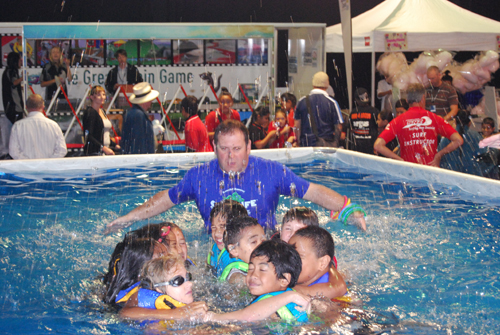

<p><img class=" alignright size-full wp-image-84" style="margin: 5px; float: right;" src="http://schoolnewsnz.fastrackdev.com/wp-content/uploads/2011/10/SN14_-_Sports__Recreation_-_Swim_for_life_-_1.jpg" alt="SN14 - Sports Recreation - Swim for life - 1" width="253" height="170" />New Zealand schools have traditionally been recognised as the primary venue for our children learning to swim,</p>
<p> <!--more--> </p>
<p>and research commissioned by Water Safety New Zealand (WSNZ) has found that 89 per cent of all schools continue to provide some form of aquatic education for their students.</p>
<p>This is a remarkable statistic given the difficult circumstances most schools must overcome to deliver a learn-to-swim programme. This is emphasised by another finding of the research in that 88 per cent of all schools recognise they need help to ensure they can provide the quality of tuition their students need. The issues are vast, but primarily have a common theme of insufficient funding, with associated problems around access to facilities, teacher training, transport, and a lack of supporting policy.</p>
<p>WSNZ has constantly promoted soundly based and well-planned aquatic education delivered through schools as the most effective, efficient, and sustainable way to provide <a class="wpil_keyword_link" href="https://www.schoolnews.co.nz/2015/10/developing-opportunities-at-school-with-a-view/" title="opportunities" data-wpil-keyword-link="linked" target="_blank">opportunities</a> for all children to learn to swim and survive. Subsequently, under the Sealord Swim For Life banner, WSNZ has embarked on the biggest learn-to-swim initiative in New Zealand for 50 years. Sealord Swim For Life is an overarching, national project established to address a dramatic decline in the swimming ability of our youth. This national project has been established to:</p>
<p>• Provide all children with access to the water</p>
<p>• Facilitate the delivery of quality swim-and- survive programmes in primary schools</p>
<p>• Provide the foundations for the development of a culture that produces generations of New Zealand families that are water safe</p>
<p>The goal of the Sealord Swim For Life initiative is to equip New Zealand children with the essential skills to swim 200 metres. The primary focus of the project is to manage the regional delivery of swim-and-survive education in schools through working with Regional Sports Trusts and Territorial Authorities. WSNZ is now active in 13 of 17 regions across the country facilitating the delivery of quality learn-to-swim-and-survive education to thousands of primary school students.</p>
<p> ;</p>
<p><strong>Does your school want help?</strong></p>
<p>For more information on regional specific Sealord Swim For Life initiatives please contact info@swimforlife.org.nz</p>
<p> ;</p>
<table style="width: 176px; height: 240px; margin: 10px; background-color: #ccffff;" border="0" cellspacing="10" cellpadding="10" align="right">
<tbody>
<tr>
<td>
<p><strong>Note for teachers</strong><br />The passport does not require the adoption of any specific learn-to-swim programme. It has been designed to fit with any quality programme and does not require that schools change, in any way, the programme they deliver to students.<br />Teachers and principals can register their school now to receive free Passports for all students by visiting <br />www.swimforlife.org.nz</p>
</td>
</tr>
</tbody>
</table>
<p><strong>The Sealord Swim For Life Passport</strong></p>
<p>One of the key tools developed to support the initiative is a &#8216;passport&#8217;. This exciting new resource has been produced to encourage students as they learn to swim and survive and is available free to all school students engaged in a learn-to-swim programme.</p>
<p>The passport is presented by Kautiki – the swimming Tiki. Tiki are unique to Aotearoa / New Zealand and have their origins in our ancient histories. They originate from the most sacred of waters, wai matua, the protective embryonic waters of the mother.</p>
<p>There are many facets to protecting our off-spring and one of the most important is to ensure they learn to swim and survive. Kautiki is the taonga of the Sealord Swim for Life initiative and is a visual reminder of how precious our children are and the importance of swimming as a survival skill.</p>
<p>Each page inside the passport takes students one step closer to being a strong swimmer. The passport is linked to the Sealord Swim For Life Achievement Framework, which lists nine skills or steps for students to achieve, beginning with fundamentals like floating and submersion, and finishing with a 200m swim.</p>
<p>There is also a series of survival skills for students to learn and numerous water safety tips on how they can stay safe in and around the water.</p>
<p>As students become proficient in each skill, teachers (or parents) can &#8216;sign off&#8217; each page and give students a sticker to recognise their progress. All students who achieve the 200m swim will be provided with a personalised certificate of achievement from WSNZ.</p>

EXCLUSIVE: Teachers used to be paid two to three times more than minimum wage workers,…
After an “overwhelming” vote to reject the latest Government offer, secondary school teachers will begin…
Second-language learning should be compulsory, says a new report from a forum bringing together academics,…
A new entitlement aimed to improve access to learning support coordinators for schools with students…
Educators have raised questions about the Ministry of Education’s new secondary school subjects, set to…
Professional learning and development (PLD) for teachers needs to be higher impact for teachers and…
This website uses cookies.